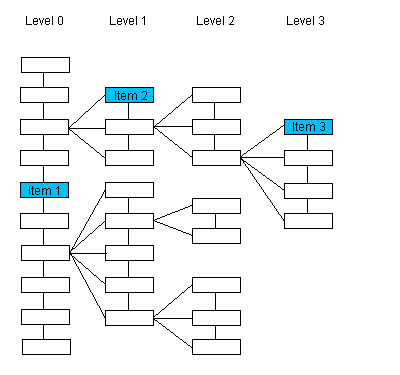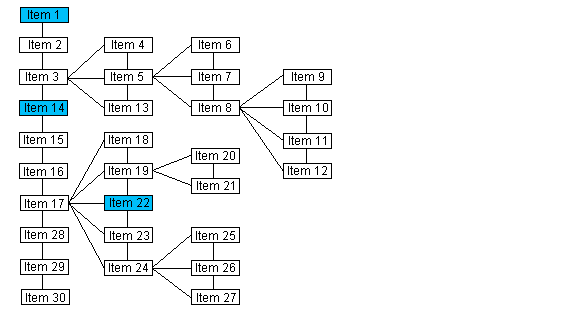

| Leadtools.Dicom Namespace > DicomDataSet Class : FindPreviousElement Method |
public DicomElement FindPreviousElement( DicomElement element, bool tree )
'Declaration Public Function FindPreviousElement( _ ByVal element As DicomElement, _ ByVal tree As Boolean _ ) As DicomElement
'Usage Dim instance As DicomDataSet Dim element As DicomElement Dim tree As Boolean Dim value As DicomElement value = instance.FindPreviousElement(element, tree)
public DicomElement FindPreviousElement( DicomElement element, bool tree )
ObjectiveC Syntax
public: DicomElement^ FindPreviousElement( DicomElement^ element, bool tree )
For the sake of the following illustrations, the order of siblings is top to bottom.
If the Data Set is evaluated as a tree structure, this method returns the previous item on the same level as element, with the same parent as element.
Please note that the numbering of the items of interest in this first illustration is arbitrary and does not imply order.

| If the passed object points to: | The method returns an object pointing to: |
|---|---|
| Item 1 | The previous sibling (same level, same parent) of Item 1 , if such an item exists. If such an item does not exist, the method returns null. |
| Item 2 | The previous sibling (same level, same parent) of Item 2 , if such an item exists. If such an item does not exist, the method returns null. |
| Item 3 | The previous sibling (same level, same parent) of Item 3, if such an item exists. If such an item does not exist, the method returns null. |
If the Data Set is evaluated as a list, this method returns the previous item in the entire list .
Please note that the numbering of the items in the following illustration does indicate the order of the items when the Data Set is evaluated as a list.

| If the passed object points to: | The method returns an object pointing to: |
|---|---|
| Item 1 | The previous item in the list, if such an item exists. If an item with Tag tag is not found, null is returned. |
| Item 14 | The previous item in the list that has Tag tag, if such an item exists. If an item with Tag tag is not found, null is returned. |
| Item 22 | The previous item in the list that has Tag tag, if such an item exists. If an item with Tag tag is not found, null is returned. |
The following methods will also help you find elements in the Data Set with a specific Tag:
The following methods will help you find specific modules in the Data Set:
Target Platforms: Windows 7, Windows Vista SP1 or later, Windows XP SP3, Windows Server 2008 (Server Core not supported), Windows Server 2008 R2 (Server Core supported with SP1 or later), Windows Server 2003 SP2